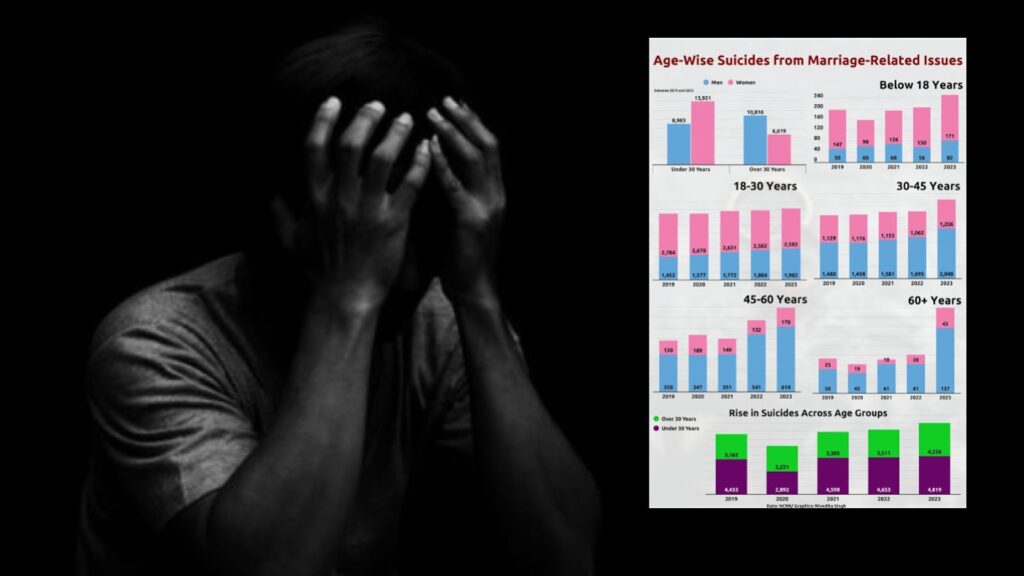More men ending their lives over marriage troubles in India, new data reveals

More men ending their lives over marriage troubles in India, new data reveals
Stark changes are emerging in India’s suicide patterns, with more men now dying by suicide over marriage-related issues than women—a shift that challenges long-held assumptions and exposes deep cracks in the country’s understanding of mental health within relationships. Once considered a predominantly female crisis, suicides linked to marital problems are increasingly claiming the lives of men at a growing rate.
Official data from the National Crime Records Bureau (NCRB) highlights a steady reversal of trends seen in previous years. In 2023, 4,863 men ended their lives due to marriage-related stress, compared to 4,180 women. A similar pattern appeared in 2022 with 4,237 male suicides versus 3,926 female suicides. This stands in contrast to 2015, when close to 4,000 women died by suicide over marriage-related issues, while the male count was significantly lower at 2,497. The gender gap peaked in 2016, with 4,368 women and only 2,512 men recorded.
While the number of daily female suicides linked to marriage has remained relatively constant—around 11 per day from 2015 through 2023—the male figure has risen sharply. By 2023, 13 men on average died each day due to marriage-related distress, compared to just 7 in 2015. That increase has pushed the overall daily average of marriage-related suicides in the country from 18 in 2015 to 25 in 2023.
Marriage remains a major factor behind suicides in India, ranking fourth among all causes—trailing behind family issues, illness, and substance abuse. Until 2017 and 2018, it held the third spot, only to be overtaken as drug and alcohol addiction cases climbed. Categories listed by NCRB under marriage-related suicides include non-settlement of marriage, dowry, extra-marital affairs, divorce, and other unspecified factors. Among these, dowry remains the only reason where women continue to outnumber men. In every other category, the male suicide toll has surpassed that of women.
Cases like that of 34-year-old Atul Subhash, a tech worker who died by suicide after accusing his estranged wife and her family of harassment, reveal a painful reality behind the data. Atul left behind a detailed 24-page note and a video claiming false legal charges and extortion—examples of how legal battles and emotional exhaustion are pushing men to the brink.
Breakdown by age presents a clearer picture of who is most affected. Between 2019 and 2023, women under the age of 30 made up the majority of suicides in their age group—13,921 women versus 8,983 men. Beyond age 30, however, the numbers shift significantly. In this group, 10,816 men died by suicide compared to 6,619 women. Men in the 30–45 age range saw particularly high figures, with 8,262 deaths versus 5,726 for women, suggesting long-term marital breakdowns, legal complications, and post-divorce trauma are weighing heavily on them.
From 2019 to 2023, 20,540 women and 19,799 men took their lives due to marriage-related causes. Although women’s total remains slightly higher, the current upward trend among men is what stands out. The higher female count during earlier years (2019 to 2021) masks the growing burden on men in the last two years. In 2019, daily averages showed two women and one man dying by suicide due to marriage issues. By 2023, this ratio flipped to three men and two women per day, with extra-marital affairs becoming an increasingly common trigger.
Silence and stigma often prevent men from expressing emotional vulnerability, leading many to suffer in isolation. Marital problems, when combined with societal pressure and legal challenges, create a heavy emotional burden—one that often goes unnoticed or is dismissed.
Greater awareness, balanced support systems, and a gender-inclusive approach to mental health are urgently needed. Treating marital distress as a shared human experience—rather than a gendered one—can help save lives and foster healthier relationships. These numbers aren’t just statistics; they represent real people, families in grief, and an urgent call to action that can no longer be ignored.










